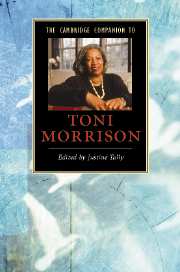Book contents
- Frontmatter
- Introduction: “All necks are on the line”
- Part I Toni Morrison’s fiction
- Part II Toni Morrison’s criticism and editing
- Part III Essays
- 11 Language and narrative technique in Toni Morrison’s novels
- 12 Toni Morrison, intellectual
- 13 Morrison and the critical community
- Part IV Further Reading
- Index
11 - Language and narrative technique in Toni Morrison’s novels
from Part III - Essays
Published online by Cambridge University Press: 28 January 2008
- Frontmatter
- Introduction: “All necks are on the line”
- Part I Toni Morrison’s fiction
- Part II Toni Morrison’s criticism and editing
- Part III Essays
- 11 Language and narrative technique in Toni Morrison’s novels
- 12 Toni Morrison, intellectual
- 13 Morrison and the critical community
- Part IV Further Reading
- Index
Summary
It would be difficult, and perhaps counterproductive, to discuss Toni Morrison's language and narrative technique without examining the social vision, reimagined relationships, and redirected gaze they are designed to support. For, as feminist narratologist Susan Lanser notes in Fictions of Authority, “Narration entails social relationships and thus involves far more than the technical imperatives for getting a story told.” The notion that extra-textual relationships can motivate, inform, illuminate, or even confound the narrative project has particular significance for an understanding of Toni Morrison's choice of literary techniques.
In “Rootedness: the Ancestor as Foundation,” an essay published in the early 1980s, Morrison clarified the social and political vision informing her writing, stating that:
If anything I do, in the way of writing novels (or whatever I write) isn't about the village or the community or about you, then it is not about anything. I am not interested in indulging myself in some private, closed exercise of my imagination that fulfills only the obligation of my personal dreams - which is to say yes, the work must be political.
At a time when the dictum of art for art's sake had not yet been stripped of its disguise, Morrison was adamant in asserting that a socio-political function neither detracted from, nor conflicted with, aesthetic worth. Equally important, she revealed that this socio-political function was inextricably connected to her relationship to the society-as-readers she called “the village.” In “Home,” an essay published in 1997 that explores contemporary cultural and social contestations around “race,” she offered a more pointed description of the “manageable, doable, modern human activity” her fiction performs, that is, creating “a-world-in-which-race-does-not-matter.”
- Type
- Chapter
- Information
- The Cambridge Companion to Toni Morrison , pp. 151 - 161Publisher: Cambridge University PressPrint publication year: 2007
- 1
- Cited by



